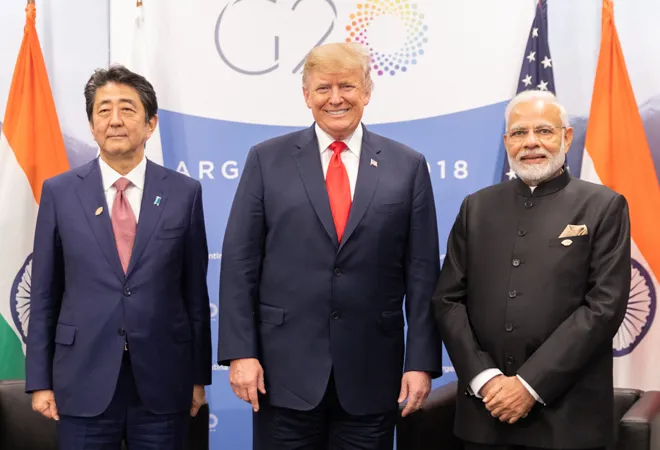Indian foreign policy is in a sweet spot these days. Wooed by major powers of all hues, it can afford to work with everyone, even if at times the pulls and pressures seem contradictory. This was even reflected at the G20 where New Delhi managed to pull off two seemingly contradictory trilaterals. Modi met with United States President Donald Trump and Japanese Prime Minister Shinzo Abe India to underscore India’s firm commitment to make the Indo-Pacific a region for shared economic growth, prosperity and security. Asserting that India will “continue to work together on shared values,” Modi said, “When you look at the acronym of our three countries — Japan, America, and India — it is ‘JAI,’ which stands for success in Hindi.” Abe hoped that the trilateral would reinforce the trilateral partnership and its close cooperation "towards realising a free and open Indo-Pacific.” Trump also acknowledged that “the relationships between our three countries is extremely good and extremely strong.. with India, maybe stronger than ever.. We are doing very well together. We are doing a lot of trade together. We are doing a lot of defence together, a lot of military purchases.” The three nations shared their views on progressing a free, open, conclusive and rule-based order in the Indo-Pacific region, based on respect for international law and peaceful resolution of all differences.
The Indo-Pacific construct is now at the centre of strategic jockeying in the region and the three nations have been trying to define the exact scope of their engagement. Modi had explained India's stand on the strategic Indo-Pacific region in his keynote address at the Shangri La Dialogue in Singapore in June. “India does not see the Indo-Pacific Region as a strategy or as a club of limited members. Nor as a grouping that seeks to dominate. And by no means do we consider it as directed against any country. A geographical definition, as such, cannot be,” he had said. But China’s rapid rise and the challenge it is posing to geopolitical stability is at the heart of the evolution of the Indo-Pacific and the trilateral in Argentina reinforced the desire of the three states to take it forward.
Hours after the ‘JAI’ trilateral, Modi joined Chinese president Xi Jinping and Russian President Vladimir Putin for another trilateral — the ‘RIC’ — the second among the three countries after a gap of 12 years. The underlying rationale for this trilateral for quite different as the three nations discussed enhancing mutual cooperation in international forums. According to the Indian Ministry of External Affairs: “They agreed on the importance of reform and strengthening of multilateral institutions that had benefitted the world, including the United Nations, WTO and well-established as well as new global financial institutions. They underscored the benefits of a multilateral trading system and an open world economy for global growth and prosperity.”
While China is the one driving ‘JAI,’ it is the Trump Administration’s challenge to the global economic order that is largely behind India’s outreach to China and Russia. The fact that New Delhi managed to pull this off is a tribute to Modi’s astute investment in managing major power relations over the last few years. This is a period of fluid partnerships and Indian diplomacy will have to be nimble enough if Indian interests are to be preserved. Modi’s engagements at the G-20 underline that New Delhi is capable to managing this fluidity.
India’s defence diplomacy is also being shaped by this reality. By the end of this year, India would have held military exercises with all P5 countries — US, Russia, China, France and the UK. So on one hand, there is the proposed military exercise with Russia and China, on the other ‘Cope India’ between the Indian and US air forces has been restarted after a gap of nine years, showcasing “US and India’s efforts and commitment to a free and open Indo-Pacific region.” India and Russia conducted Indo-Russia Joint Military Exercise-Indra 2018 in Madhya Pradesh last week while Indo-UK Konkan naval exercise is currently underway, off Goa, which is focusing on anti-air warfare, anti-surface warfare, anti-submarine warfare, visit board search and seizure (VBSS) and seamanship evolutions. The Japanese Air Self Defence Force (JASDF) is in India for a bilateral air exercise "SHINYUU Maitri-18" with the Indian Air Force (IAF). Defence Minister Nirmala Sitharaman is visiting the US Indo-Pacific Command in Hawaii to chart the course for the first ever India-US tri-service military exercise off in Bay of Bengal in May-June 2019. At the same time, the armies of India and China will be resuming their annual bilateral military exercise 'Hand in Hand' in December.
India’s defence diplomacy has become truly ‘multivector’ and it is aimed at enhancing India’s strategic partnerships. It is a sign of India’s growing global profile that most powers want to engage India on military and defence issues. The more partnerships India has, the better leverage it will have with in diplomacy. But it is also important to recognise the challenges that come with this. Ultimately, India will have to enhance military interoperability with like minded countries and that’s unlikely to happen if New Delhi will continue to keep its eggs in multiple baskets. It is good to be in a position where everyone wants to befriend us but Indian policymakers should be aware of the fundamental challenge: which of these countries would come for help in face of an existential challenge?
The views expressed above belong to the author(s). ORF research and analyses now available on Telegram! Click here to access our curated content — blogs, longforms and interviews.




 PREV
PREV


